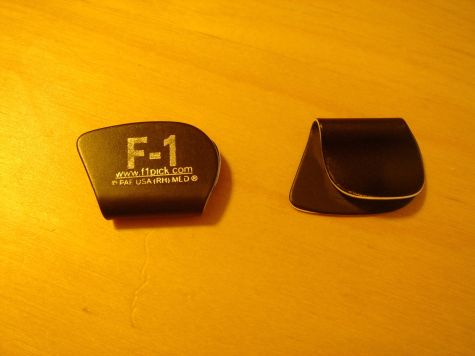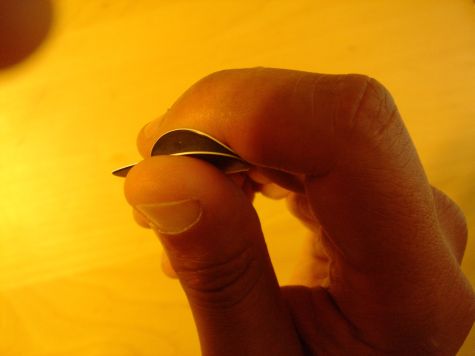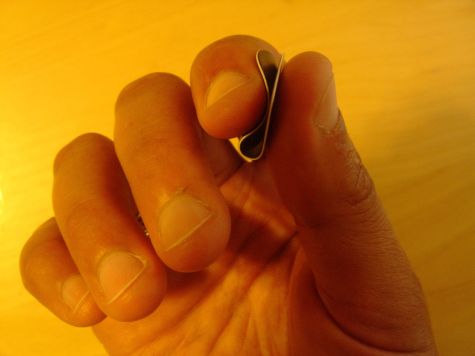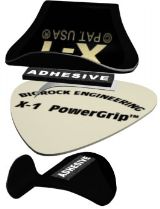Big Rock Guitar Picks
Guitar picks, despite varying in size, thickness and material, typically share one common trait – they’re flat and thus lack an adequate grip surface. Sweaty fingers and/or heated play can lead to trouble holding the guitar pick as it shifts position or ends up being dropped. In response, the guitar player may end up squeezing the plectrum harder thus creating tension in the hand, arm and shoulder. As a result, picking accuracy and speed can suffer and this extra tension can contribute to Repetitive Stress Injury (RSI).

Big Rock Engineering thinks there’s a better way – a guitar pick with a built in grip as seen below. I had the opportunity to try two variants over the course of several months – the one piece guitar pick called the F-1 which integrates a concave grip into the design and the X-1 which is actually a grip kit that let’s you add the concave grip surface to a conventional plectrum.

Observations
To prove the concept to myself, I played with the F-1 pick almost exclusively for several months and the results were very positive. Initially, the picks felt different but I quickly got past that. After a few minutes, I found that I could relax my grip and not worry about the pick sliding around in my fingers. I quickly realized that I could spend less time thinking about what my fingers were doing to retain a conventional guitar pick and focus more on actually playing.

I also find that my entire arm is more relaxed now. While tension may be focused in a particular area it has an impact on other parts of the body as well. Thus by relaxing my hand, my forearm and shoulder are also more relaxed. By reducing tension, a guitarist should find that their picking becomes more fluid, more accurate and potentially faster.

I also tried the X-1 grip surface (seen in the illustration below) on a couple of conventional picks and liked the results. These install easily with double sided tape that’s included with them. While the F-1 pick’s grip surface is designed to contact the index finger, the X-1 grip surface can be used for the index finger, the thumb or both (if you place one on either side of the pick). It’s an excellent solution for guitarists committed to a particular brand of pick who still want the benefits of the grip surface.

One suggestion – don’t install the index finger grip straight up and down on the pick. Hold your hand in a relaxed picking position and note the slight bend in the index finger joint. To accommodate this bend, install the X-1 at a slight angle. BTW, the F-1 pick’s grip already accounts for this and is molded in at a slight angle.
And did I mention these guitar picks seem to wear like iron? I spoke to Big Rock Engineering’s Allan Chance about this and he thinks this has largely to do with the light touch these picks encourage.
Final Thoughts
Big Rock’s guitar pick solutions provide the best grip out there and the F-1 guitar pick is now my favorite pick. I find myself turning to it over my prior favorite – the Dunlop Nylon Jazz III Guitar Pick. When I do use the Dunlop’s, I find my picking hand much more relaxed so the Big Rock solution also has potential as a training tool in teaching your hand to relax.
While a bit pricier than the average guitar pick, the difference in cost is insignificant given the benefits to the guitar player from reduced tension and the opportunity to play more fluidly with less risk of RSI. Consider how much we spend on instruments, amplifiers and other guitar accessories then go try these out for yourself. They’re worth it.
It looks like a really good product. I’ve never gotten used to using a pick, as it never felt natural to me. The F-1 and X-1 look as they might feel like a natural extension of your hand.
Do you know of a European distributor?
I found an old thumbpick the other day, BTW, and tried using it as an ordinary pick. It worked quite well, because stuck in its place by itself and I didn’t feel I had to grip it tightly not to loose it.
I’m really impressed with these picks and they do feel quite natural. I’ve also tried thumb picks but I find these a good deal more comfortable and natural.
As far as availability, you can actually order directly from their site. Let me find out what other distribution methods might exist in Europe and I’ll report back!
[…] August 21st, 2007 · No Comments “Guitar picks, despite varying in size, thickness and material, typically share one common trait – they’re flat and thus lack an adequate grip surface. Sweaty fingers and/or heated play can cause the guitarist to struggle to control the pick as it shifts position or ends up being dropped. In response, the guitar player may end up squeezing the plectrum harder thus creating tension in the hand, arm and shoulder. As a result, picking accuracy and speed can suffer and this extra tension can contribute to Repetitive Stress Injury (RSI).” Read about Big Rock Guitar picks. […]
Robert, how does this fare with the long winded pick essay by Tuck Andress I posted you a while back? He came to the conclusion how to hold the pick in the most efficient and – thus – ergonomic way. This seems contradictory. I wonder how Big Rock picks FLEXES. Do they? The most important thing to me is to have it rock steady and you shouldn’t be able to move it at all even with your other hand trying to move it.
Needles to say, I’m one for large thick, and hard picks, that one can hide in you hand while fingerpicking, and does not spoil my finger nails. So, I am using STONE PICKS. Yes, the most unergonomic pick there ever was! I have just two. One, that I’ll NEVER take out of my house, because I haven’t found anything like it. I’m too scared to lose, drop, crack it. It’s slippery and takes ages before you can master it, but once you do, it’s like a violinists bow.
The violinst may very well sell or trade his Stradivarius, but he’ll never sell or trade his bow.
The stone pick angle just cuts right through the strings, and makes them SLIDE off rather than the abrupt sharp point from a regular plastic. Stone picks never wear, and you can do a lot of hard rock tricks with it, bagpipe effects, banjo like stuff, bird chirps, seagull cries, japanese koto impersonations… cure cancer, rid nations of evil, create world peace… All simultaneously!:-) … or so I’ve heard! 🙂
Seriously, I wonder how the big rock picks flexes. I am about to order the online – because you can – it’s not that big deal if they turn out to be nothing. Stone picks are far more expensive. Nothing you throw out to the audience at the end of gigs…;-)
Not having yet experimented with Tuck’s theories on holding a pick (I’m challenged enough with a conventional grip), I can’t directly speak to them.
Held in a conventional manner, the Big Rock pick works very well and they’re available in a heavy gauge. I prefer the heavy gauge picks although they’re nowhere near as thick as the Dunlop Jazz III picks I was previously using. If it helps, I don’t particularly miss the Dunlops despite the difference in thickness and rigidity. Of course, guitar playing styles vary so your mileage may differ. Nonetheless, they serve a great purpose and I think a lot of folks will find them valuable once they get past the fact that they’re “different”.
An alternative to the F-1 pick is the X-1 grip which you can add to a conventional pick and get the best of both worlds. I’ve experimented with the grip on several picks so far – a very rigid stainless steel pick and a Dunlop Jazz III. It works great with the steel pick although its a little trickier on the much smaller jazz pick although it still works. The cool thing about the X-1 grip is the ability to orient it to follow the index finger or thumb. You can even make a full sandwich of it and put one on either side. Personally, I prefer the index finger grip but its great to have the options.
Thank you for elaborating, Robert. I find a three finger grip keeps the pick from flexing even more. I don’t know how the X-grip will accomody three finger gripm though. Using the side of index finger seem to be – to me – an inefficiency. There’s no mucsles on the index finger that can make pressure upwards towards the pick from the sideways. You just have to use the thumb for all of the force.
The stone pick I use is a drop shaped – It’s called the MIN’D PICK – that can rest all across the side of the index finger which makes a terrific balance. It has the same size as the side of my index finger. I have some peculiar stance, that the more skin and bone to pick surface there is for holding a pick, the better. Both from an ergonomic thing and a stamina, pressure and wide variation thing.
I want to be able to change sound by slightly angling my pick while playing. And to do pick harmonics. Is this possible with big rock F-1 or X-1?
The only way I can see these accomodate a three finger grip is if you use the X-1 grip on the thumb rather than the index finger. The F-1 is specifically designed for the conventional index finger and thumb grip with the pick’s gripping surface aligned with the index finger.
I don’t see why you wouldn’t be able to angle the pick while playing – neither the F-1 nor the X-1 lock your finger joints in a particular position.
I bought a bunch of these, but should have only bought one :-\ The problem is they have a very thin sound to my ears. Which is not surprising since they are made of very thin material.
It’s amazing how much difference in sound you can get by just using different picks and though I was a little concerned that they might not sound as good as my regular picks (Pickboy Jazz) my natural enthusiasm got the best of me.
I haven’t tried the one that grips any pick and since I spent so much getting a bag full of ones that sound lousy (to me) I probably won’t for a while, but I think that would be the way to go.
As far as the ergonomics it does feel good, although it encourages (enforces?) a certain angle of attack that might not be right for everyone. So if I had it to do over I would buy the one with the sticky stuff and use my own picks.
First off, welcome Anthony!
I’m sorry to hear that the sound doesn’t work well for you. But keep in mind that you’re doing an apples to oranges comparison. The F-1 heavy pick is the thickness of a conventional heavy pick. The Pickboy Jazz is extra heavy at 1.5mm so I’m not surprised that you hear a difference. Those are even heavier than the 1.38mm Dunlop Jazz III’s I had been using which are very stiff and used by several big players for just that reason – Joe Bonamassa and Eric Johnson come to mind.
The two are also quite different in terms of the shape – another contributor. Again, the F-1 is more like a conventional pick while the Pickboy and Dunlop Jazz picks share a sharp point.
Market forces being what they are and the fact that the F-1 caters to a comparatively smaller market, I can understand why they may not have as great a variety.
Maybe what we need is an extra heavy gauge F-1 pick with a more distinctive point! I’ll shoot them an email suggesting it.
BTW – I tried the X-1 grip on the Dunlop Jazz III. Personally, I find it works better on a standard sized pick but it is workable.
I appreciate your input!
The Dunlop Jazz III comes in a large pick as well, they’re called “stiffo”. There were a need, for those thinking that the shape and thickness of a jazz III would be great only if they were larger. Now, with “stiffos” you could try the x-1 grip. The “stiffo” from Dunlop is the only one that I switch when I am leaving my stone picks at home. Too scared to lose them.
In the past I used to use green Sharkfin picks! They were so thin, that they resembled something cut out from a plastic bag. However, anyone noticed the striking resemblance of a sharfin pick and the body of a Klein guitar? Anyway, I thought I use and switch between both extremes because that was the only difference a listening person could tell. If I played with a thinner that thin sharkfin, or a stone pick. I went for “as thin as possible” or “as thick hard and heavy as possible”. The sound changed accordingly and I used them for different purposes.
Is there a preference with the F-1 pick, say, do they cater more to acoustic guitar playing or electric? Or they’re equally as good on either?
I would not try the X-1 grip on my stone picks that’s for sure, but probably on 2-3 of my Dunlop “Stiffos”.
/Mats
Thanks for the tip on the Stiffo! I’ll check these out for use with the X-1 grips.
As far as the F-1, it works equally well for either electric or acoustic playing. They’re not targeting a particular type.
What concern do you have with the stone pick and the X-1 grip? It adheres with strong sticky tape but it can be removed.
I don’t want to experiment with the x-1 grip on
anything that ain’t easily replaceable, that’s all. Or experiment in any other way, not jsut the x-1 grip.
Here’s the manufacturers link to “stiffo’s”:
Jim Dunlop Stiffo Guitar Picks.
The Jazz Nylon XL to the right of the ordinary classic Jazz III…
There’s the JAZZ XL No 47rxl. Black Stiffo Nylon (!?)Mind you, red ones aren’t called stiffo, it’s the black one. The black coloring actually hardens the pick even more. Even ordinary jazz III users says this, that the red ones feels a tiny bit softer. I find it peculiar, but hey, whatever. They do sound and acts like the regular Jazz III but with a larger gripping surface, which suits me fine, easier to hide when just fingerpicking, and does give room for my nails.
Try the X-1 grip on these. I think Big Rock should produce something in that vein, big thick, and hard. Non-flexible pick.
Fair enough Mats! I’ll let Big Rock know they have at least three potential customers for an extra heavy super stiff pick. 🙂
Just an update – I let Big Rock Engineering know about the comments so far and the suggestion to come out with a super stiff pick. They are considering the feasibility.
I’ve been using the F-1 for electric rock/jazz guitar, acoustic bluegrass/country, and mandolin celtic/bluegrass. My overall experience with the pick (plectrum) has been monumental. I’ve been playing semi-pro for over 25 years and this is by far the best pick I’ve ever used.
If there is room for ergonomic improvement I don’t see where. The pick is awesome, outstanding, and with two thicknesses to choose from, you can apply the advantages of both to the style and instrument of your choice.
The majority of time I use the F-1 medium (0.75mm) black for electric/acoustic guitar and the F-1 heavy (1.0mm) black for mandolin and it truely is what sounds best with what instrument. Ocassionally I’ll use the heavy with jazz.
If you’ve not tried this pick before and are looking for an improvement in your dexterity via a more secure grip, fluent play and more precision through consistency of grip and relaxation and practicing with the F-1, then get one and use it with enthusiasm and evaluate it.
Mike Levine
real person and independent of this web site.
Thanks for the input, Mike! The only thing I’d like to see is the availability of an even stiffer pick. I’ve mentioned this to the folks at Big Rock Engineering so we’ll see what happens.
Now, having tried the grip on a Nylon “stiffo” for a month or more I can say, that the stiff pick becomes more flexible when added these things on. Note, I have not their actual pick, but their grip – thanks to you Robert – attached to a Dunlop Jazz III BIG Nylon pick. I put them on according to their instructions at the site, and was quite picky that it attached the right way to the millimeters.
I find the grip more convenient for pure flatpicking on acoustic but for all these tiny little tricks I do on electric, doing hammerons with the side of the pick (i e bagpipe effect) and angle the pick for pinched harmonics and stuff it’s quite a closed shop to that kind of playing. You must have it in flat direction most of the time. It’s hard to “caress” the string with your pick and bring in some flesh from the fingers too.
Also, the combined fingerpicking, with pick and fingers together turned out slightly more awkward as I usually move my pick deeper into my grip so all fingers are closer to the strings. I e I change grip on pick all of the time, and stuck it away under my palm, when using all fingers temporarily and thumbing. This was harder to tuck away the pick with these things on. Also, it was a tad harder to do arpeggios when skipping strings, say, jumping to high e directly from low e string, in a fluent way. I had a hard time to hone in this, since I couldn’t aim correctly.
At first it felt very clumsy, but I got around to it. But still it makes the pick flex more than without the grip, and definitely more than I like (eating energy) as it hits the string, so my verdict is that while I think it is a step in the right direction, it didn’t run home with me at full points as of yet. I am not going to switch over,
yet.
/Mats
Thanks for the input Mats! The X-1 grips definitely have a different feel than the F-1 pick. The adhesive pad creates a bit of play in there so it’s not for everyone. As I mentioned to Mike (above), I’d like to see an extra heavy F-1 pick. It seems a lot of players like using very stiff picks and it might be a good idea for them to cater to this preference.
Agree 100%. A 2mm would be nice, in any of the materials…you get more when there’s more surface and string connecting.
I second that…despite being very intrigued, I rarely find a use for any pick of a lesser gauge than 3.0 mm